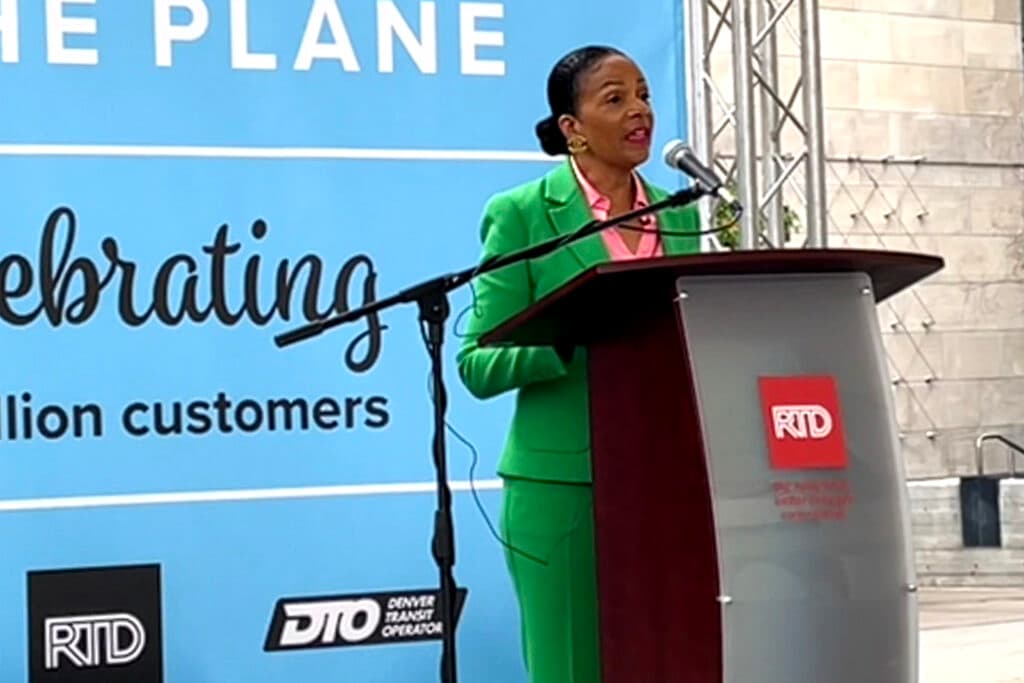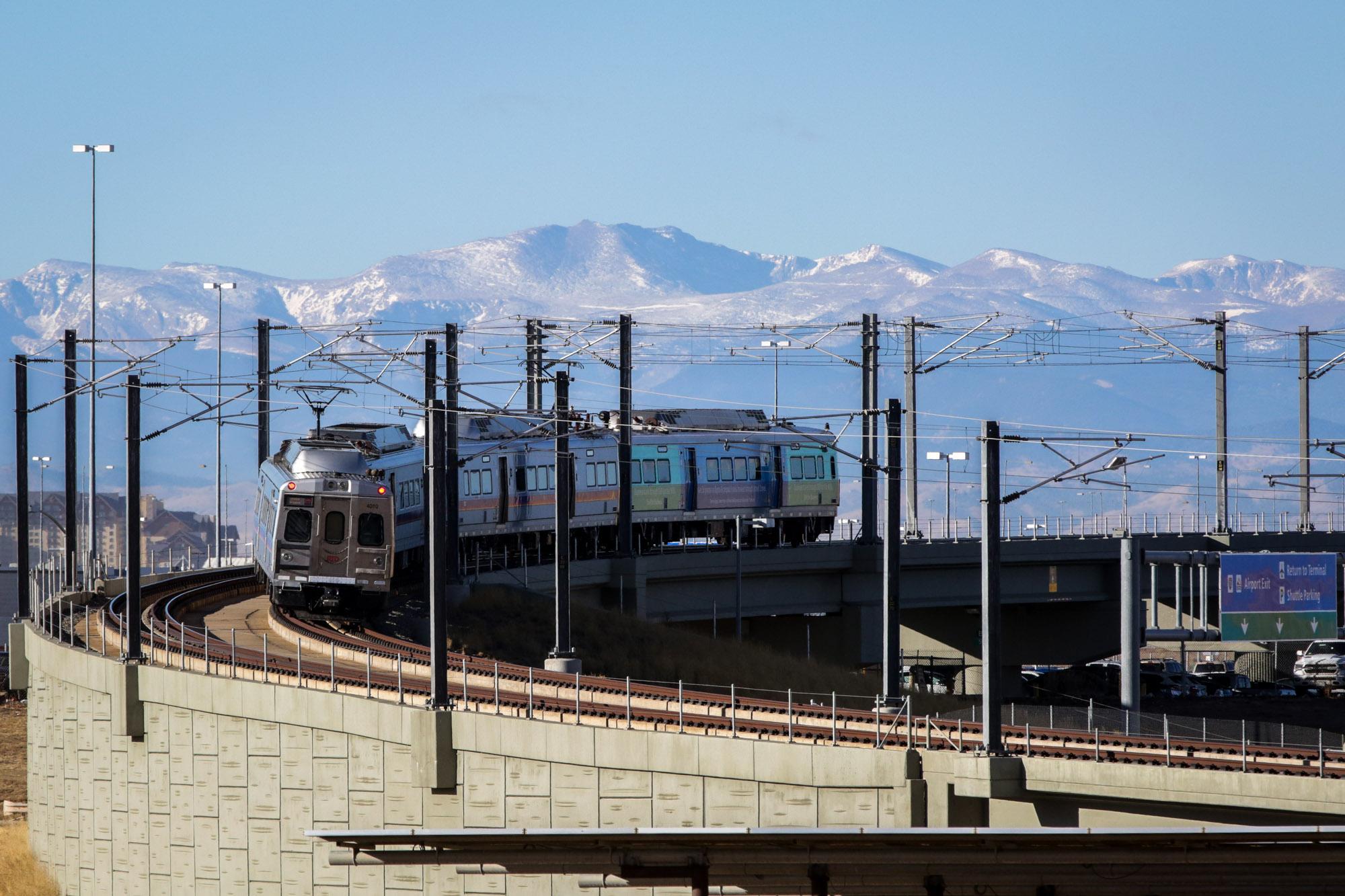The Regional Transportation District’s top brass were all smiles Tuesday as they celebrated the A Line between Denver International Airport and downtown reaching 50 million customers since it opened in 2016.
“Each of them is the reason for the A Line’s success,” RTD’s General Manager and CEO Debra Johnson said at a press event at Union Station. “For thousands of people each day, the A Line is their lifeline to home, work, medical care, education, and services that are central to their lives and key to Denver's economy.”
After some initial very serious mechanical and operational issues, the A Line has turned into RTD’s most used rail line. And while RTD’s light rail network has suffered recently because of delayed maintenance, the commuter A Line has remained reliable.
But while RTD touts the success of the A line, a Denver City Council member told Denverite that she recently felt lobbied by the agency — interpreting a phone call before a crucial vote as RTD saying it was not interested in upgrading the A Line.
It’s all part of a tangled debate over the best way to get more people to and from the airport, whether it is more rail cars or passenger vehicles.
DIA is making plans for Peña Boulevard. The A Line isn’t a part of them.
Airport officials for years have been collecting public input and formulating plans for its main driveway to the city, the oft-congested two-lane Peña Boulevard freeway.
DIA’s master plan for Peña sets out five road-only alternatives that will set guardrails on the project as it goes through the federal environmental review process. Options include adding managed toll lanes that buses could also use and new frontage roads for local traffic.
But airport CEO Phil Washington has already said publicly what he wants: a “very responsible” expansion of Peña Boulevard. Airport officials have also set goals of boosting transit ridership among passengers and airport employees.

Through this process, transit advocates have been pushing for airport officials to also study improvements to the A Line that parallels Peña. Among the transit upgrades they want is the addition of another track in sections where RTD only built one to save money. The single track sections and track constraints near Union Station limit A Line frequency to 15 minute intervals during peak times.
DIA officials have said that federal laws and policies prevent the airport from directly paying for A Line improvements. But it’s not known if they are right about that. As of last fall they hadn’t asked the federal government for permission to do so.
Still, the advocates’ push to make the A Line better caught the attention of some Denver City Council members who are concerned that a wider Peña Boulevard will only lead to more traffic, local air pollution, and global climate emissions in the long run. They wanted the airport to include A Line improvements in their Peña study.
But RTD’s intervention flipped one of those councilors in a crucial vote.
The Denver City Council narrowly approved a bill in March that helped fund the road-only Peña Boulevard study.
The bill would have failed if not for RTD, one council member now says.
Councilwoman Flor Alvidrez told Denverite this week that she had opposed funding the road-only study. But just before the vote, a DIA official asked RTD’s government relations officer to inform Alvidrez and other councilors about the transit agency’s “limitations to expanding the A Line,” according to internal emails obtained by Greater Denver Transit and shared with Denverite.
RTD’s government relations officer replied that he would, “explain that RTD is participating in the DEN working group discussions related to Pena, provide background on RTD’s current A Line operations, and provide a summary of what it would take to study A Line expansion if their [sic] was a desire.”
Alvidrez said the RTD representative told her the A Line wasn’t yet at capacity and that it would be difficult for them to land funding until it was. She interpreted the phone call as RTD saying it had no interest in improving the A Line.
“I was very shocked,” Alvidrez said, adding: “I can't imagine why RTD wouldn't be fighting for some funding to make the train service better or safer or anything. So the fact that RTD was calling me to tell me that they didn't want any additional funding, honestly, was really confusing. It made no sense to me.”
So she changed her vote, and the study funding bill passed seven to six.
“I did change my vote,” she said. “I wanted more funding to go to RTD so they could improve their public transit to the airport. But when RTD is calling you telling you ‘we don't want it,’ it's like, ‘why am I going to fight for them?’ “
In a statement, RTD’s spokesman Stuart Summers said the agency has actively engaged in the airport’s Peña study and that its staff “did not ask any members of Denver City Council to vote a certain way or discuss funding prior to the March 2024 bill to study Peña Boulevard.”

Asked on Tuesday why RTD hasn’t pursued A Line improvements, its leader Debra Johnson echoed what her employee told Alvidrez — that train cars aren’t yet routinely full, and there’s a lack of funding. She’s also adopted a “back to basics” strategy that prioritizes financial stability and maintenance — and she pointed out that RTD already has other unfunded projects on its to-do list.
“There are some corridors that don't have any type of transit service,” she said.
Advocates, though, say they aren’t happy with Johnson and RTD’s approach to Peña Boulevard and the A Line.
“If it is true that even just a single vote on the council was flipped in favor of more road building due to input from RTD, that would raise serious questions about the agency’s current policies and leadership,” Richard Bamber, co-founder of Greater Denver Transit, said in a statement.
Alvidrez said she is hopeful that if a managed lane is eventually built on Peña, RTD will be able to run more buses to make use of it.
Correction 7/17/24: The original version of this story contained an inaccurate job title for the RTD official who contacted City Council Member Flor Alvidrez.

